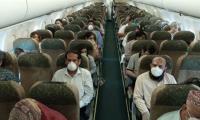PARIS: As the coronavirus pandemic bears down on vulnerable nations in Africa and South Asia, experts say there are only weeks to help fill chronic shortages of what medics need to help people breathe. Not ventilators, but oxygen itself. Medical oxygen is a core component of the life-saving therapies hospitals are giving patients with severe cases of COVID-19, as the world waits for scientists to find vaccines and treatments.
The pandemic has pushed even the most advanced health systems to their limits, with concerns often focused on the supply of mechanical ventilators at the high-tech end of the breathing assistance spectrum. But experts fear this has distorted the narrative about what constitutes an effective response, giving the wrong blueprint for nations with under-funded health systems. “The reality is that oxygen is the only therapy that will save lives in Africa and Asia-Pacific now,” said Hamish Graham, a consultant paediatrician and research fellow at Melbourne University Hospital and International Centre for Child Health. “I fear that undue focus on ventilators without fixing oxygen systems will kill.”
One report in February on thousands of cases in China´s epidemic found that nearly 20 percent of patients with COVID-19 required oxygen. Of those, 14 percent needed some form of oxygen therapy, while a further five percent required mechanical ventilation. In severe cases of COVID-19, the virus attacks the patient´s lungs in the form of pneumonia, causing inflammation that prevents them from absorbing oxygen. This can cause their blood oxygen levels to fall well below normal, a condition known as hypoxaemia that can deprive critical organs of oxygen and “substantially” increase the risk of death, Graham said. “In hospitals in high-income countries, we take oxygen for granted,” he told AFP. “In low-resource settings, healthcare workers are acutely aware of the challenges as they fight to get oxygen to patients every day.”
Many larger hospitals across Sub Saharan Africa and South Asia will have some oxygen cylinders in operating theatres and wards, as well as concentrators — portable devices that filter and purify the surrounding air. But surveys throughout Africa and Asia-Pacific have shown that less than half of hospitals have oxygen available on wards at any given time, Graham said, and even fewer have the pulse oximeters that allow medical staff to measure blood oxygen levels and guide dosages.
‘Helpless’: Oxygen supply has long been a source of alarm among specialists who treat pneumonia, the world´s biggest preventable infectious killer of children under five. In Nigeria, one of the worst-affected countries, the government introduced a national policy several years ago to improve pneumonia treatment, but experts say it has not trickled down to a regional level. Adamu Isah, who leads Save the Children´s work on pneumonia in the country, said the charity recently assessed primary healthcare facilities in two states and found that oxygen supplies were “really, really concerning”.
A former clinical physician, Isah said it was common to see children “suffering and gasping”. “If you don´t have something like an oxygen system you find yourself helpless, there´s really not much you can do,” he told AFP. A 2018 report published by Every Breath Counts, a coalition of UN agencies, businesses, donors and aid agencies, said supplies of oxygen were “severely limited” in countries across South Asia and Sub-Saharan Africa. It cited surveys that suggested only one in 10 children with pneumonia in Nigeria received the oxygen they needed. In Ethiopia, research found that while 64 percent of hospital paediatric wards had oxygen supplies, only 14 percent had health workers trained to use them or standard operating procedures. Leith Greenslade, the lead coordinator for Every Breath Counts, said the mining industry often has better oxygen supplies for its workers than under-funded hospitals. “These health systems in Africa and South Asia could not be more exposed to a pandemic like this one because they haven´t been investing in respiratory therapy,” she told AFP. “This is what terrifies me.”
‘Flying blind’: Despite pneumonia killing 800,000 children a year globally, campaigners say it has not been given the same attention as other infectious diseases like HIV, Malaria and TB. Greenslade said global health authorities have also “completely neglected” oxygen, and this means there is very little information about supplies. “The absence of global data on this is going to be a major problem trying to respond to COVID-19 because we are flying blind, we really don´t know which countries are in more desperate need than the other,” she said.
South Korean troops walk outside the National Assembly after President Yoon Suk Yeol declared martial law, in Seoul,...
A view of Iran's capital city Tehran under smog. — AFP/FileTEHRAN: Students and civil servants in parts of Iran were...
A representational image of a doctor examining a patient. —Unsplash/FileLONDON: Private doctors will be barred from...
Rebel fighters stand next to the burned gravesite of Syria’s late president Hafez al-Assad at his mausoleum in the...
US Secretary of State Antony Blinken attends an interview, in Brussels, Belgium December 4, 2024. —...
Parts of a ballistic missile, which Russia used in a strike towards Dnipro city this week, are displayed, amid...







